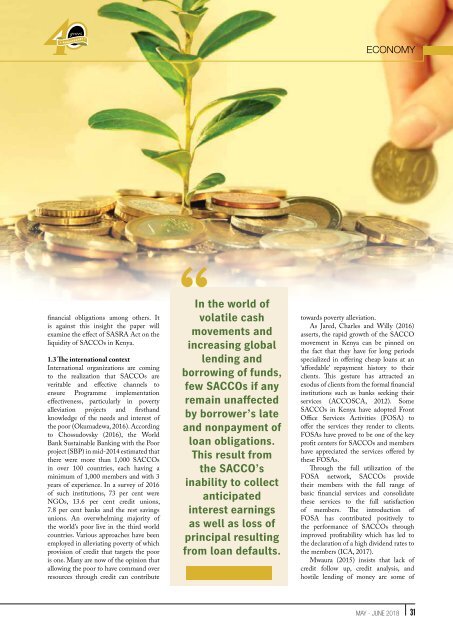May-June-issue
You also want an ePaper? Increase the reach of your titles
YUMPU automatically turns print PDFs into web optimized ePapers that Google loves.
Economy<br />
financial obligations among others. It<br />
is against this insight the paper will<br />
examine the effect of SASRA Act on the<br />
liquidity of SACCOs in Kenya.<br />
1.3 The international context<br />
International organizations are coming<br />
to the realization that SACCOs are<br />
veritable and effective channels to<br />
ensure Programme implementation<br />
effectiveness, particularly in poverty<br />
alleviation projects and firsthand<br />
knowledge of the needs and interest of<br />
the poor (Okumadewa, 2016). According<br />
to Chossudovsky (2016), the World<br />
Bank Sustainable Banking with the Poor<br />
project (SBP) in mid-2014 estimated that<br />
there were more than 1,000 SACCOs<br />
in over 100 countries, each having a<br />
minimum of 1,000 members and with 3<br />
years of experience. In a survey of 2016<br />
of such institutions, 73 per cent were<br />
NGOs, 13.6 per cent credit unions,<br />
7.8 per cent banks and the rest savings<br />
unions. An overwhelming majority of<br />
the world’s poor live in the third world<br />
countries. Various approaches have been<br />
employed in alleviating poverty of which<br />
provision of credit that targets the poor<br />
is one. Many are now of the opinion that<br />
allowing the poor to have command over<br />
resources through credit can contribute<br />
In the world of<br />
volatile cash<br />
movements and<br />
increasing global<br />
lending and<br />
borrowing of funds,<br />
few SACCOs if any<br />
remain unaffected<br />
by borrower’s late<br />
and nonpayment of<br />
loan obligations.<br />
This result from<br />
the SACCO’s<br />
inability to collect<br />
anticipated<br />
interest earnings<br />
as well as loss of<br />
principal resulting<br />
from loan defaults.<br />
towards poverty alleviation.<br />
As Jared, Charles and Willy (2016)<br />
asserts, the rapid growth of the SACCO<br />
movement in Kenya can be pinned on<br />
the fact that they have for long periods<br />
specialized in offering cheap loans at an<br />
‘affordable’ repayment history to their<br />
clients. This gesture has attracted an<br />
exodus of clients from the formal financial<br />
institutions such as banks seeking their<br />
services (ACCOSCA, 2012). Some<br />
SACCOs in Kenya have adopted Front<br />
Office Services Activities (FOSA) to<br />
offer the services they render to clients.<br />
FOSAs have proved to be one of the key<br />
profit centers for SACCOs and members<br />
have appreciated the services offered by<br />
these FOSAs.<br />
Through the full utilization of the<br />
FOSA network, SACCOs provide<br />
their members with the full range of<br />
basic financial services and consolidate<br />
these services to the full satisfaction<br />
of members. The introduction of<br />
FOSA has contributed positively to<br />
the performance of SACCOs through<br />
improved profitability which has led to<br />
the declaration of a high dividend rates to<br />
the members (ICA, 2017).<br />
Mwaura (2015) insists that lack of<br />
credit follow up, credit analysis, and<br />
hostile lending of money are some of<br />
MAY - JUNE 2018 31

















